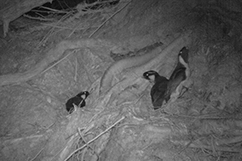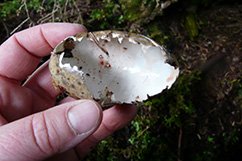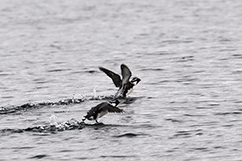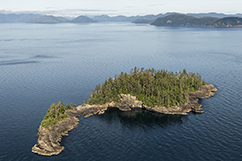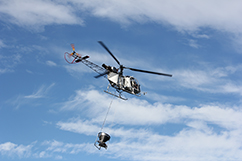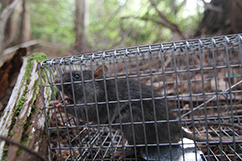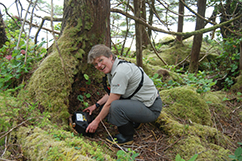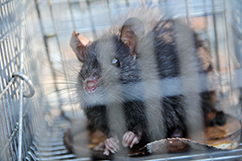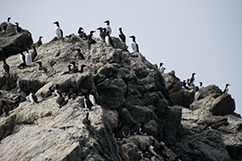SG̲in X̲aana Sdiihltl’lx̲a: Night Birds Returning
Transcript
Parks Canada beaver logo fades in and out. Haida music.
Haida Nation logo / Canada wordmark fades in and out
Cut to sunrise timelapse
[Music starts]
Aerial shot of sun rising, taken from a helicopter
Aerial shot of forest, taken from a helicopter
Shot of monumental pole (rack focus)
Cut to shot of visitor looking at monumental poles
Underwater shot of kelp
Bear scavaging for food on beach
Aerial shot of sea lions on rocks
Haida dancer
Shot of black oystercatcher on rocks
Harlequin ducks on rocks. Music fades into the background.
[Carita Bergman, Parks Canada]
Literally millions of birds migrate to Haida Gwaii every summer to have their chicks.
Aerial shot of forest
The rainforest of the remote islands here harbour over 100 species of breeding birds.
Ancient Murrelet chick in burrow
Parks Canada employee in cave with headlamp
The Ancient Murrelet is a species at risk in Canada and over 50% of the entire global population nests on Haida Gwaii,
and almost half of those are right here in Gwaii Haanas.
Map showing Gwaii Haanas National Park Reserve, National Marine Conservation Area Reserve, and Haida Heritage Site
Some people have asked me, “why is the Ancient Murrelet such an important species?”
Ancient Murrelets on water
and I like to think of them as a barometer of the health of not only the oceans where they feed,
Timelapse of islands
but also the remote islands where they have evolved for thousands of years in complete isolation.
Haida wearing a hat, taking in the scenery. Background music fades out.
Carita Bergman sits on rock, talking
Most visitors to these islands view them as peaceful, quiet retreats,
Lapses into a night-time shot while Carita speaks. Birds chirp in the background.
but at night, these islands really come to life.
Night shot of active Cassin's auklets
Shot of an ancient murrelet burrow at night
Ancient Murrelets evolved to return to their burrows in the dark of the night
to avoid avian predation from native predators such as Bald Eagles and Peregrine Falcons.
Carita Bergman at an ancient murrelet burrow at night
So here are we are at an Ancient Murrelet burrow
and you can see that they’re pretty cryptic and often hard to spot.
Shot of inside the burrow with ancient murrelet chick
Unlike other birds whose chicks remain in their nests for weeks,
Ancient murrelet chicks travelling from their burrows to the sea. Upbeat music in the background.
Ancient Murrelet chicks tumble from 1their burrows after only 1 or 2 days
drawn to the sea by the calls and songs of their waiting parents.
Shot of a rat on the beach
Unfortunately this is the time of the night when rats are most active
and this puts Ancient Murrelets at great risk of local extinction
on islands where rats have been introduced.
Back to a shot of ancient murrelets dashing to the ocean. Upbeat music stops.
[Birds chirping]
[Music starts]
Ancient murrelet carcass and feathers. Haida music starts.
Sadly though, whole colonies of Ancient Murrelets as well as other seabird species
Rat runs across the beach
have been lost as introduced rats continue to spread throughout the archipelago.
Parks Canada staff embarking on a boat
Staff in discussion as boat moves across the water. Music stops.
Parks Canada, the Haida Nation, and several partners are working together to restore these critical island habitats.
Laurie Wein speaks with ocean as backdrop. New upbeat music track starts.
[Laurie Wein, Parks Canada]
The Night Birds Returning Project is about restoring globally significant seabird populations
particularly those of Ancient Murrelets.
[Music starts]
Ancient murrelets on the ocean
Rat swimming in the ocean
Invasive species like rats are the number one threat to the ecological integrity of Gwaii Haanas.
Rats are voracious in terms of their consumption of eggs of seabird chicks
Shot of a bird carcass and broken eggs
Shot showing rats active at night in forest. Music stops.
they will even take adult seabirds.
The Ancient Murrelet, or the Night Birds as the Haida call them, are particularly impacted by rats.
We’re concerned about their breeding habitat and their breeding success on these islands.
[Music stops]
Timelapse of an island goes from black and white to colour
There have been over 300 successful rat eradications from islands globally.
Staff looking at map. Music in the background.
And we’ve looked to many of those to learn lessons that we could apply here in the Haida Gwaii context.
Staff getting reeady to disembark boat with rat eradication equipment
[Chris Gill, Coastal Conservation]
The Night Birds Returning project has been in planning and development,
and in the implementation phase, since 2009.
Because this is Canada’s first aerial eradication of rats,
we wanted to make sure that we had as many experts as possible to help us with the planning of this project.
Person on a beach looks through binoculors
[Pete McClelland, Coastal Conservation]
Globally now, we’ve got an eradication community that shares information.
Over time, we’ve gotten to more complex and larger islands,
and what had started in New Zealand now is being done in many countries around the world.
A group of people study information on a laptop
[Laurie Wein]
We first started planning the project for a ground-based eradication on smaller islands of Bischofs and Arichika.
Person climbs on rocks near a boat
Aerial shot of an island
Using what we learned from our pilot projects,
we moved on to tackle much larger islands of Murchison and Faraday.
Shot of island from window of a helicopter
These were logistically much more complicated to plan an eradication on,
and required new techniques.
Group in talks as helicopter flies by
The technique that we focused on was an aerial broadcast methodology;
Shot of helicopter with bucket
And we chose that technique because it gave us the highest probability of eradication success.
Shot of pilot and co-pilot from inside the flying helicopter
Helicopter with bucket flies low over the island
It allows to tackle islands of much more complicated terrain, and much bigger in size.
[Gregg Howald, Island Conservation]
Gregg Howald talking while sitting on rocks
The implementation of rat eradications are not taken lightly.
#REF!but 2, that the potential impact from the bait that you're using
Helicopter drops bucket on to barge and bucket gets refilled
the mitigation will be appropriate to minimize the risk to the non-target species.
Shot of helicopter taking off, from underneath
Every eradication brings with it the risk of non-target impacts where species that you don’t want to eat the bait do
Person works on a laptop
But with planning and good implementation,
Slo-mo of ancient murrelet birds flying above the ocean
those populations soon recover and far outnumber what they were initially.
A rat runs across rocks
You’re removing predation, you’re removing competition,
Ancient murrelet chicks move across rocks
and so the species come back and the ecosystem as a whole is much healthier.
Montage showing ancient murrelets in the water
At the end of the day, this project is not about the removal of rats from the islands,
it’s really about the recovery of the seabird, the local seabird populations.
And ultimately about restoring balance to the ecosystem.
Sun sets on the islands. Music stops.
Text on screen [In the absence of rats, native shorebirds and songbirds on these islands are once again thriving]. Haida music.
Text on screen [In the coming years, it is expected that breeding seabirds will re-establish their colonies in these areas.]
Point-of-view shot of boat moving through water at sunset
Text on screen [Restoration of islands is critical to safeguarding the extraordinary diversity of native species found on Haida Gwaii and around the world.]
Text [Video and music credits]
Text on screen [special thanks to our partners: Coastal Conservation; Island Conservation, Preventing Extinctions; Conservacion de Islas; Laskeek Bay Conservation Society; Simon Fraser University.]
Text on screen [Financial support was provided by: Luckenbach Oil Spill Restoration Council; NFWF; National Conservation Plan.]
Parks canada signature
Text fades in and out [Copyright Her majesty the Queen in Right of Canada, represented by Parks Canada, 2015]
Haida Nation logo / Canada wordmark fades in and out
How to Pronounce SGin Xaana Sdiihltl’lxa in Xaayda Kil
This translates to "Night Birds Returning"
Seabirds at risk
Ancient Murrelets (or "night birds" as translated from the Haida language) are a species at risk in Canada. Their population in Gwaii Haanas has been devastated by invasive rats.
Between 2011 and 2013 a major ecosystem restoration project called SG̲in X̲aana Sdiihltl’lx̲a: Night Birds Returning took place in Juan Perez Sound to remove rats from select islands.
SG̲in X̲aana Sdiihltl’lx̲a: Night Birds Returning has resulted in successful habitat restoration following the project. However, rats have been detected migrating across islands in recent years. The Haida Nation, Parks Canada and Fisheries and Oceans Canada are working together to continue protecting Ancient Murrelet habitat.
An irreplaceable habitat
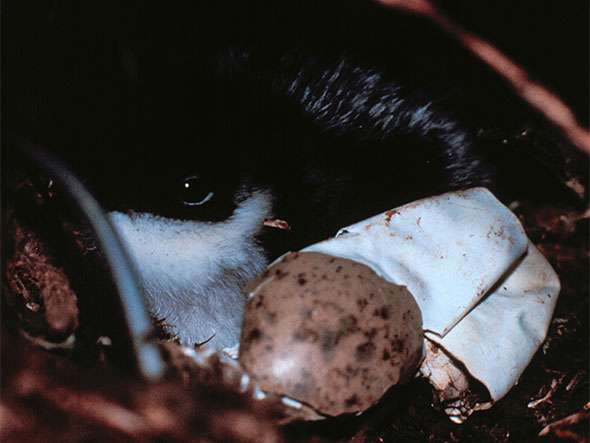
A significant number of the world population of Ancient Murrelets breed on remote islands in Gwaii Haanas. These seabirds spend most of their lives on the water. They only come and go from small islands during breeding season.
Ancient Murrelets breed by night laying two eggs in a burrow. Hidden under the forest floor, the tiny chicks hatch. Within days, the chicks scuttle through the night-shaded undergrowth. They follow the sound of their parents as they are called to the sea.
These seabirds also once played an important role in the diet of the Haida. The colonies were once prime food gathering places.
Devastated by rats
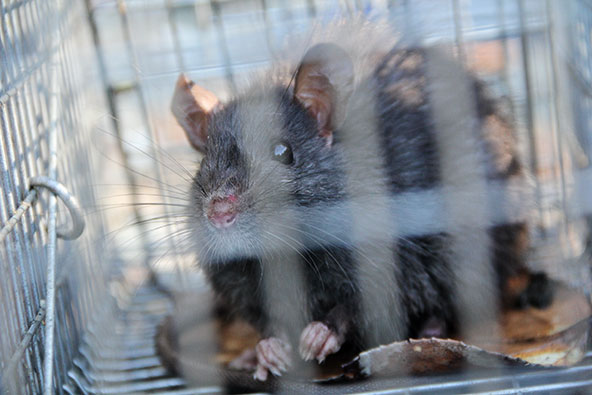
Rats were first introduced to Haida Gwaii with the advent of maritime shipping in the late 1700s. Two types of invasive rats are currently found in Gwaii Haanas: black rats and Norway (brown) rats. They are known to occur on at least 18 islands throughout the archipelago. Their presence has had a devastating effect on the seabirds of Gwaii Haanas, eating eggs, young and even nesting adult seabirds. This has caused the birds to abandon many rat-infested islands.
The projects: Restoring habitat by removing rats
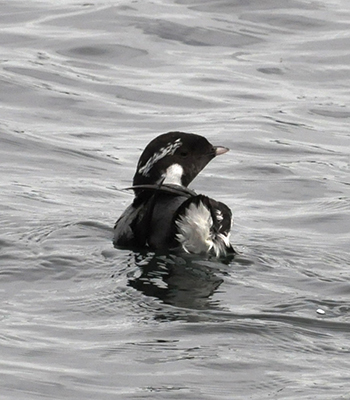
Parks Canada, the Haida Nation and several international partners are committed to restoring seabird habitat on several remote islands in Gwaii Haanas.
SG̲in X̲aana Sdiihltl’lx̲a: Night Birds Returning aimed to restore habitat and improve ecological integrity. This project launched in 2009 with phase one occurring in 2011, and phase two in 2013. Both phases focused on the eradication of invasive rat species on specific islands. This includes Arichika, the Bischofs, G̲aysiigas Gwaay (Murchison), and Daa.a Gwaay (Faraday). The eradication of rats is necessary to improve habitat for Ancient Murrelets and other seabirds in Gwaii Haanas.
The protection of species at risk is a high priority for Parks Canada. Through initiatives like this, Parks Canada is achieving conservation results.
Phase one: 2011
In 2011, Parks Canada, the Haida Nation, Island Conservation and Coastal Conservation implemented the eradication of invasive Norway rats from Arichika and Bischof islands. Arichika and Bischof islands were once home to significant Ancient Murrelet colonies. This work was supported by Parks Canada’s Action-on-the-Ground program. This program funded ecological restoration across Canada’s national parks. It was also funded by the US Coast Guard’s Oil Spill Liability Trust Fund. This fund was set up to offset the damage done to seabirds by a sunken oil tanker, the S.S. Jacob Lukenbach. It went down in 1953 off the coast of California.
Ground-based eradication
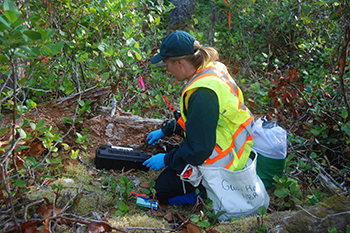
A three-month ground-based eradication effort was carried out by field crews. This operation involved using a rodenticide in the specialized stations. Daily monitoring and removing rat carcasses by hand also took place.
Results on Arichika and Bischof islands
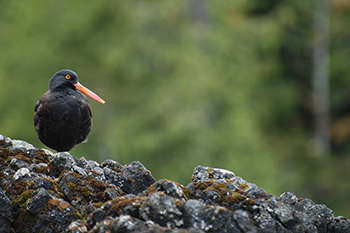
- Scientists successfully managed for the possibility that other species could have been affected by the eradication. This resulted in very few impacts on other species and no population-level impacts.
- Within years, populations of native shrews on Arichika and Bischof islands returned to levels comparable to islands without rats.
- Immediately after the removal of rats, Black oystercatcher numbers started increasing and fledging more chicks. Black oystercatchers are a shorebird. They are considered by scientists to be a sentinel species. This means that they respond quickly to changes in ecosystem health.
- As of 2019 Arichika Island remains rat-free. Seabird calls captured on acoustic recording units continue to increase.
- Eradication on the Bischof Islands was also successful. However, several rats have been detected recently. It is believed these rats have re-invaded from the neighbouring Lyell island, or from elsewhere.
Phase two: 2013
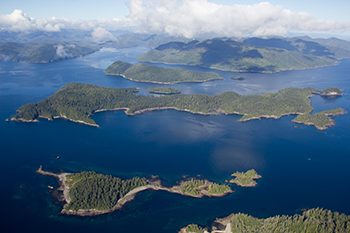
In September 2013, the eradication of black rats took place on Murchison and Faraday islands. Collaboration took place between Parks Canada and the Haida Nation, and its partners Coastal Conservation and Island Conservation. Parks Canada also drew on technical expertise from international experts in New Zealand and Mexico. Financial contribution came from the US National Fish and Wildlife Foundation – a non-governmental, charitable body established by the US Congress.
Murchison and Faraday islands are located within the Juan Perez Sound. This area includes islands recognized internationally for their globally outstanding seabird populations (Ancient Murrelets, Cassin’s auklets) and other seabird (Leach’s storm-petrels, Fork-tailed storm-petrels) and shorebird species.
Murchison and Faraday islands are close to Ramsay Island, which at the time was rat-free. The removal of rats on these two islands aimed to reduce the risk of a rat invasion to nearby intact seabird colonies.
Aerial eradication
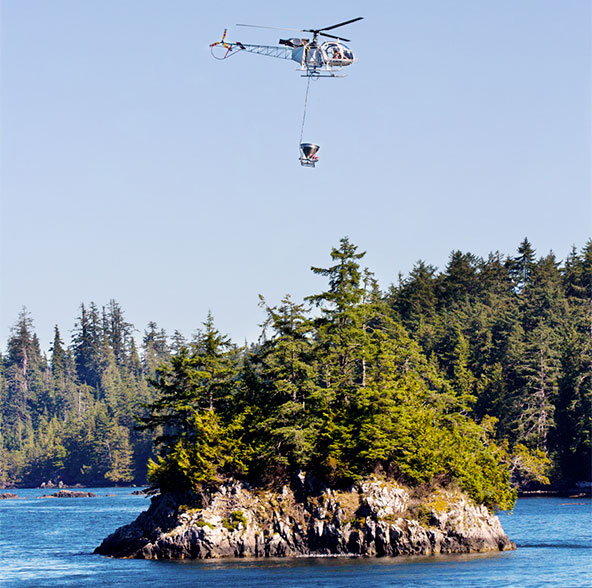
The eradication of black rats from Murchison and Faraday islands was completed by helicopter. Bait containing a rodenticide was dispensed from the air using a device made for the project. The device allowed bait to be dropped in precise locations. The rodenticide was also tailor-made for the project to be as unattractive as possible to non-target species.
This aerial technique is similar to aerial seeding applications used in forest or agricultural management. It is also a proven conservation management technique for removing rats from islands and restoring native species. It has been used extensively in New Zealand, Mexico, the United States and the Galapagos.
Results on Murchison and Faraday islands
- Following the eradication, native species started responding to the absence of rats. In 2016, a six per cent increase in the calls of Ancient Murrelets on both islands was observed. Detection was through the use and analysis of automated acoustic listening devices.
- Gwaii Haanas field staff observed more shore crabs in the intertidal zone on both islands. More crabs indicate less rats living on those islands.
- Black oystercatcher numbers started increasing on Murchison and Faraday islands following the removal of rats from the islands.
- In 2016, after continued monitoring Murchison and Faraday Islands were declared rat free.
- In September 2017, wildlife cameras set to detect small mammals showed evidence of Norway rats on Murchison and Faraday islands. This species is new to these islands. Their population is considered low at this time.
- There continues to be no evidence of black rats on Murchison and Faraday islands.
Continued monitoring and research
2017
Monitoring and research has continued since Norway rats were detected on Murchison and Faraday islands in 2017.
In order to determine where the Norway rats on Murchison and Faraday came from, DNA samples were sent to University of British Columbia Okanagan. Results found that these rats are related to rats on Tllga Kun Gwaay (Lyell Island). Lyell Island is one of the larger landforms in Gwaii Haanas. It is located to the north, less than 1 kilometre away. It is still unknown how the rats got across to Murchison and Faraday islands. It could have been by swimming, drifting on a log or via a vessel.
2018
In September 2018, wildlife cameras picked up evidence that Norway rats had migrated to G̲andll K’in Gwaay.yaay (Hotspring Island) and Aataana Gwaay.yaay (House Island). Rodenticide was distributed on Hotspring and House islands and islets in November to eradicate an estimated 6-12 rats.
2019
In July 2019, Norway rats were discovered on Taw HlG̲aahl Gwaayts’ads (Tar Island), and K’aadxwa Xyangs Gwaayts’ads (Agglomerate Island), followed by Xiina Gwaay.yaay (Ramsay Island) and again on Hotspring Island in August 2019. This is the first time rats have been detected on Tar, Agglomerate and Ramsay islands.
Ongoing Monitoring and Next steps
To find out more about rat population dynamics, data continues to be collected and analyzed. Time is also being spent carefully analyzing past restoration and biosecurity efforts to plan a future response. Before any further conservation work on invasive species occurs, local and international partners are assisting the Gwaii Haanas team to determine next steps and biosecurity measures. An Invasive Species management plan is being developed to better understand invasive species and the direction that should be taken.
Help prevent the spread of rats
Travelling to Gwaii Haanas? Rats are great stowaways. Help prevent rats from being introduced to more islands. This can be done by maintaining a rat-free vessel.
- Keep food, waste and gear in rat-proof, sealed storage areas.
- Inspect your boat regularly for signs of rats. This includes droppings, nests and chewed food, wood or wires.
- Know which anchorages have rats nearby.
- Clean up any debris that could shelter rats.
- Use rat guards on ship-to-shore lines to prevent rats boarding at ports.
- Install traps on your boat.
- Seal all entry points on your boat. Rats can crawl through holes as small as 1 cm.
- Never throw a rat overboard, they are good swimmers and may reach land.
Gwaii Haanas provides all boaters travelling to the area free Rat Aware Kits.
Happy rat-free sailing!
Photo gallery
- Date modified :
